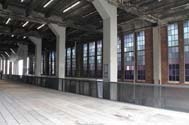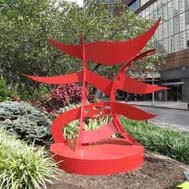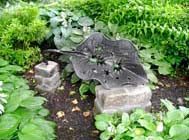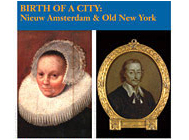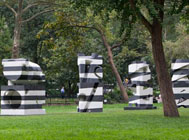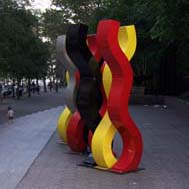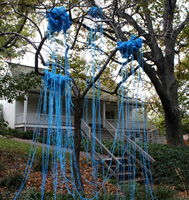Art in the Parks
Through collaborations with a diverse group of arts organizations and artists, Parks brings to the public both experimental and traditional art in many park locations. Please browse our list of current exhibits and our archives of past exhibits below. You can also see past grant opportunities or read more about the Art in the Parks Program.
Public Art Map and Guide
Find out which current exhibits are on display near you, and browse our permanent monument collection.
Search Current and Past Exhibits
2009
Manhattan
Franz West, The Ego and the Id
July 1, 2009 to July 16, 2010
Doris Freedman Plaza, Manhattan
Please note: This is a past exhibit that is no longer installed in the park.
The Ego and the Id is internationally acclaimed artist Franz West's newest and largest aluminum sculpture to date. Soaring 20 feet high, the piece consists of two similar but distinct, brightly colored, looping abstract forms, one bubble gum pink and the other alternating blocks of blue, green, orange, and yellow. Each of the forms curve up at the bottom creating stools that invite passersby to stop, take a seat, and directly engage with the artwork.
This is a project of the Public Art Fund.
![]()
Spencer Finch, The River that Flows Both Ways
June 2009 to June 2010
The High Line, Manhattan
Please note: This is a past exhibit that is no longer installed in the park.
The River that Flows Both Ways is a bank of colored glass windowpanes along the tunnel over Chelsea Market. For his project, Stephen Finch took one day to photograph the Hudson River's surface 700 times, taking one shot every minute. These images have been transferred onto 700 panes of glass and placed onto pre–existing windows, which have been installed in a semi–enclosed tunnel between 15th and 16th streets, above the New York City High Line, from which the river can be seen. The piece, which uses a single pixel point from the photographs for each pane of glass, is a study on the ever–changing color of water. The tunnel itself transforms throughout the day as the levels of light shift with time. The title is the translation for the Native American name of the Hudson River, Muhheakantuck.
Finch was born in New Haven, Connecticut and is currently based in Brooklyn, New York. His works constantly seek to unveil the nature of light, color, perception, and memory. This project was organized by Creative Time, Friends of the High Line, and NYC Parks.
![]()
Peter Coffin, Untitled (Sculpture Silhouettes)
October 1, 2009 to May 6, 2010
City Hall Park, Manhattan
Please note: This is a past exhibit that is no longer installed in the park.
Populating City Hall Park with monumental silhouettes of iconic sculptures, Peter Coffin’s Untitled (Sculpture Silhouettes) installation takes the viewer on a journey through the history of sculpture in space and time. Allusions to Auguste Rodin’s The Thinker, an Easter Island moai, Louise Bourgeois’ Untitled (With Hand), one of Sol LeWitt’s Incomplete Open Cubes, and Pablo Picasso’s She Goat, among others, hover like apparitions throughout the Park. Ranging in size from eight to ten feet tall, their commanding sculptural presence is somewhat of an illusion; each work is only one inch thick. The sculptures slip in and out of view, similar to the way in which memories slip in and out of one’s mind. The decision to hold the vision in place or let it fade is left to the viewer.
The Sculpture Silhouettes refer to timeless icons drawn from the history of art. In transforming famous works of art into flattened silhouettes devoid of their original volume, Coffin engages the viewer to reflect and expand upon the existing associations each form’s representation evokes. This idiosyncratic sculptural survey creates an environment in which variations on seminal sculptures are experienced in a new and unexpected context. Provoking an interplay of associations, the Sculpture Silhouettes prompt the viewer to project the present onto the past, suggesting that history is constantly being rewritten.
Peter Coffin’s previous projects include constructing and flying a U.F.O. over the Baltic Sea and south‐east coast of Brazil, transforming a greenhouse into a “music for plants” performance space, and designing an elaborate machine that transports a single helium balloon along what could be its own, perhaps wind‐driven natural course. Playfully giving substance to the invisible and sometimes impossible, Coffin’s work invokes art history, fringe and pseudo science, social psychology, and epistemology to explore interpretation and perception.
Peter Coffin was born in 1972 in Berkeley, California; he lives and works in New York City. He has had recent solo exhibitions at the Aspen Art Museum, Aspen (2009); Barbican Art Gallery, London (2009); CCA Wattis Institute for Contemporary Arts, San Francisco (2009); Centre dʹArt Contemporain, Fribourg, Switzerland (2008); Andrew Kreps Gallery, New York (2008); Palais de Tokyo, Paris (2007); Le Confort Moderne, Poitier, France (2007); Herald St., London (2007); The Horticultural Society of New York, New York (2007); Galerie Emmanuel Perrotin, Paris (2007); and has participated in recent group shows including Altermodern: Tate Triennial, Tate Britain, London (2009); Abstract America, Saatchi Gallery, London (2009), Untamed Paradises, MARCO, Museo de Arte Contemporanea de Vigo, Vigo, Spain (2008); and Learn to Read, Tate Modern, London (2007).
This is a project of the Public Art Fund.
![]()
Carole Eisner on Broadway
September 8, 2009 to April 23, 2010
Broadway, various locations, Manhattan
Please note: This is a past exhibit that is no longer installed in the park.
This exhibition of nine sculptures by Carole Eisner has been organized by the Broadway Mall Association in conjunction with the Parks Department and Susan Eley Fine Art. The display starts to the south with the whimsical “Walter” at Dante Park, located within the Lincoln Square Business Improvement District, and continues north along seven malls maintained by the BMA, culminating with Eisner’s most recent work “Swizzle” at Mitchel Park. At each location viewers can hear the artist discuss her work by calling a special number with their cell phones.
Specific works and locations include:
Swizzle, Mitchel Square, Broadway at 166th Street
Giunta, Broadway Mall at 145-146 Streets
Circus, Montefiore Square, 137th Street
Dogon, Broadway Mall at 113-114 Streets
Puzzle, Broadway Mall at 91-92 Streets
Ziggurat, Broadway Mall at 83-84 Streets
Torque, Broadway Mall at 75-76 Streets
Dali’s Mustache, Broadway Mall at 67th Street
Walter, Dante Park, Broadway at 64th Street
![]()
Richard Baronio, Spotted Leaf
June 2, 2009 to March 30, 2010
Fort Tryon Park, Manhattan
Please note: This is a past exhibit that is no longer installed in the park.
Richard Baronio’s Spotted Leaf is perfectly suited for its temporary home at the Heather Gardens in Fort Tryon Park. Inspired by his love for gardening, Baronio’s work pays homage to the beauty found in nature. Through the technique of addition and subtraction, Baronio allows his work to grow on its own, never forcing its shape into any particular form. Spotted Leaf is an improvisational piece made from welded stainless steel.
![]()
City Lore, Birth of a City
September 1, 2009 to March 10, 2010
City Hall Park, Manhattan
Bowling Green, Manhattan
Please note: This is a past exhibit that is no longer installed in the park.
On September 4, 400 years to the month from when Henry Hudson and some 20 seamen sailed their ship the Halve Maen (Half Moon) into New York Harbor, City Lore and NY 400 opened Birth of a City: Nieuw Amsterdam and Old New York, celebrating the city’s colonial Dutch heritage with illustrated signs throughout lower Manhattan. A stencil on the sidewalk maps out the historic waterline, and demonstrates how the village of Nieuw Amsterdam was nestled within what is now the bustling Lower Manhattan cityscape. An informal stroll along the marked pathway of Birth of a City shows how Dutch traditions of commerce, government, religious tolerance, and ethnic diversity helped shape the rise of New York and the United States.
Two of the twelve signs in the tour are in city parks, at Bowling Green and City Hall.
![]()
Mel Kendrick
September 17, 2009 to February 15, 2010
Madison Square Park, Manhattan
Please note: This is a past exhibit that is no longer installed in the park.
In this exhibition, a new series of five large-scale, striated cast stone sculptures by New York-based sculptor Mel Kendrick run down the center of Madison Square Park’s oval lawn. Kendrick’s abstract sculptures are cast in black and white stone from molds carved from EPS foam. This series of new works constitute a significant evolution in the oeuvre of a sculptor who has been exhibiting his work to critical acclaim since the mid-1970s. While they continue to reflect Kendrick’s career-long focus on the creative process and investigation of the relationship between materials and form, these bold and imposing new works (standing nearly 12’ tall) will be among his largest, as well as some rare works in cast stone from an artist renowned for his use of wood. This is a project of the Madison Square Park Conservancy.
![]()
Paolo Corvino, Tempo # 5
July 27, 2009 to February 7, 2010
Dag Hammarskjold Plaza, Manhattan
Please note: This is a past exhibit that is no longer installed in the park.
Native New Yorker and former prizefighter Paolo Corvino has experimented with many artistic styles. His recent sculptures, geometric abstractions like Tempo # 5, have presented brightly–colored, minimal forms. This work is made from painted aluminum.
![]()
Tanja Smeets, Unbridled Fractals
November 12, 2009 to December 13, 2009
Dyckman Farm House
Dyckman House Museum, Manhattan
Please note: This is a past exhibit that is no longer installed in the park.
Tanja Smeets invades the historic Dyckman Farmhouse Museum and its grounds with her colorful organic, biomorphic sculptures to investigate the theme of roots and belonging. Dyckman Farmhouse was built by William Dyckman c. 1784 on land gathered by generations of Dyckmans, starting with the first family member to arrive in the 1660's. While Smeets considers these previous claims of ownership she treats the historic structure as a canvas to explore her ideas. Rather than 18th century goods, her sculptures use industrial materials, such as Lycra threads, plastic hoses, and concrete spacers.She develops hyperorganic shapes that can ooze through barriers, infiltrating and merging with the identity of the historic site. Her sculptural creatures challenge viewers to consider how and why they determine something or someone belongs. The farmhouse is an ideal setting for these explorations because it is itself an unexpected "creature" in its urban neighborhood. In her work at the Dyckman Farmhouse Tanja uses the concept of fractals, infinitely complex and irregular organic shapes that interweave with their environment.
![]()

